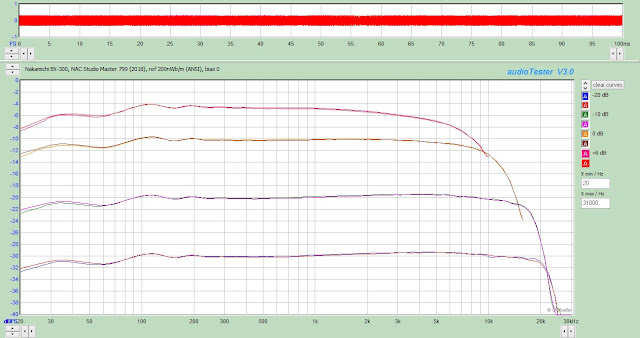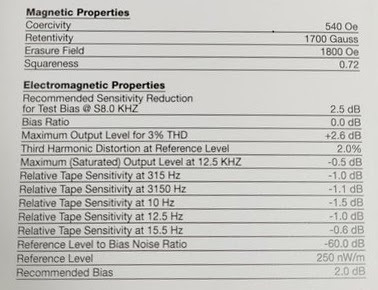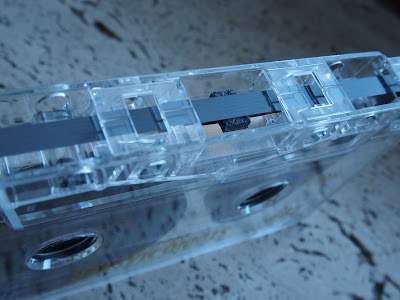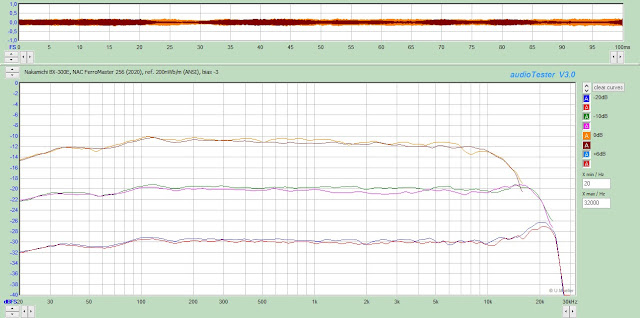Introduction
In this installment I look into some of the blank tapes sold as New Old Stock (NOS) or as brand-new by the few players that are still, or newly, in the game.
All measurements here are relative to my calibration references, Maxell XLII 1994 for type II and UR 1994 for type I.
For details on the measurement method looks here.
NAC Studio Master 799 (second version, 2018)
Relative bias: 0Relative sensitivity: +0.3dB
THD at Dolby level: 0.55%
MOL400(THD=1%): +2.4dB
MOL400(THD=3%): +6.1dB
MOL1k(THD=3%): +5.9dB
SOL10k: -4.0dB
Bias noise: -53.2dB, -57.2dB(A)
Dynamic range: 63.3dB
NAC provided the datasheet of BASF/Emtec CP Super duplication tape with this cassette. Incidentally, ATR Magnetics offered the very same datasheet for the tape loaded in their 2019 ProChrome cassette. So for a while these tapes appeared to be one and the same.
Despite the name, the high MOL and relatively high noise are proof that this is ferro-cobalt, much like Maxell or TDK made. Pure chrome, or even chrome with cobalt ('Chrome Plus'), this is not.
This tape performed very well, being compatible with XLII, even exceeding its MOL, but sadly at the cost of some extra noise. 799 resembles BASF Chrome Super II 1995 a lot, with exactly the same noise, but 1dB better MOL and SOL. Tapeheads member sr2245 found that this tape looks identical to, and measures almost the same as, year 1998 BASF Chrome Maxima II and also Reference Master II.
ACHTUNG!
799 has been on the market since 2010 or so. There are indications that the tape I tested differs markedly from what was sold under the same name and with the same cosmetics until 2016 or 2017: the older tape allegedly suffered from low sensitivity and a need for low bias ... in other words the typical shortcomings of age-degraded chrome dioxide. See here.
NAC Studio Master 799 (third version, 2021)
Relative bias: -5Relative sensitivity: -1.0dB (instable)
THD at Dolby level: 3.8%
MOL400(THD=1%): -5.6dB
MOL400(THD=3%): -1.0dB
MOL1k(THD=3%): +0.5dB
SOL10k: -4.1dB
Bias noise: -51.5dB, -54.5dB(A)
Dynamic range: 53.5dB
In 2020 National Audio Company promised to bring a brand-new type II ferro-cobalt tape to the world. Initially it was to use Asian pigment (which then???), later they reverted to a home-brew formula. End of 2021 the waiting was over. The tape was initially named 'C756', but then got incorporated in the same '799' cassettes NAC provided earlier. The same tape is now also in ATR Cobalt Gold and Cobalt Silver, and in TASCAM Master 424.
I can't say that my expectations were high, given NAC's track record with their C456 and C256 ferrics (see below). Ferrics are much easier to make than cobalt-doped tape, so if you cannot master the first, what are the chances you can pull it off with the second? The one glimmer of hope I had was the association of (once) famous brand names with this tape. Surely it could not be too bad, then?
Well, here we are. The tape, nearly black in colour, is not perfectly smooth. It still has striations, parallel with the direction of travel (see images below, click to enlarge).
It is unlikely that this is a true ferro-cobalt as we have known the type since 1974, as this would imply the advanced technique of cobalt adsorption. 799 MkIII probably is merely cobalt-doped, like Scotch High Energy.
Magneto-acoustically ... it works. But, as seen before with NAC's ferrics, the lack of coating uniformity translates in signal levels fluctuating with at least +/-0.5dB. The tape is massively overbiased at normal IEC2 (i.e. SA/XLII/UX levels). I had to reduce fine bias to the minimum on the BX-300 to obtain a flat response. Output levels are very low and distortion very high, of the same order as severely degraded chromium dioxide. SOL is OK, small wonder at such a low bias, but noise is as high as Scotch XSII. Together with the extremely low MOL this yields the worst dynamic range I've ever seen for a type II cassette, dethroning Philips CD Extra with almost 4dB! Even a basic ferric like RTM Fox, penalised by its 120us replay equalisation, does 3dB or more better!
Looking at the spec sheet (see Tascam link above) three things are immediately obvious. Coercivity is a low 540 Oe, about the level of 1975 TDK SA. Modern type II cassettes are around 700 Oe. The coating is 4 micrometers thick, versus the more usual 5-6 micrometers. This must affect MOL badly, there simply is less magnetic material available to accept signal. Finally the -60dB bias noise relative to 250nWb/m is simply not realistic, not even with a track width of 1.5mm (i.e. mono). Perhaps the spec sheet was compiled at 9.5cm/s? Even then it seems a lot of wishful thinking.
The small (3dB) difference between MOL and SOL suggests that this tape would be better served at a higher absolute bias, with the concomittant drop in treble response compensated by recording equalisation (bringing the difference between MOL and SOL closer to 7dB). This might increase the usable dynamic range with a few dB. The cost would be in having to modify the deck's circuits around this particular tape, more of less what NAC themselves hint at. This may be acceptable for a duplicator or a portastudio, but not for a general purpose cassette deck.
I do not have the habit of listening in this series of objective articles, but this time I could not resist. I spent some 2 minutes recording Jennifer Warnes' Bird On A Wire on the BX-300. The level fluctuations were not directly audible and severe dropouts were absent over this short span. The - very obvious - bias noise sounds remarkably kind and even, and when there is music ... it sounds plausible, not conspicuously broken. Provided the recording levels stay very low, of course. And even then there is appreciable compression.
NAC Audio Pro 731 (2018)
Relative bias: +2Relative sensitivity: -3.2dB
THD at Dolby level: 2.4%
MOL400(1%): -3.4dB
MOL400(3%): +0.8dB
MOL1k(3%): +3.2dB
SOL10k: -1.3dB
Bias noise: -46.9dB, -50.1dB(A)
Dynamic range: 50.9dB
In some publications this tape is named '731', in others 'Low Noise High Output'. It is allegedly sourced from Saehan.
A profoundly strange tape. For starters, it is a low-budget product, but it demands higher bias than UR. That is a bit unusual. Sensitivity is about the lowest I have ever measured (except for age-deteriorated chrome). MOL400 is bad, but surprisingly MOL1k and SOL are pretty decent. All of this shows that this tape is very unbalanced, perhaps more an exercise in cost control than in actual magneto-acoustical design. To top this, bias noise is simply bad. This cassette should be named 'High Noise Low Output'. But to be fair, I don't think this tape was ever actually meant for music and for serious recorders.
NAC Ferro Master C456 (2019)
Relative bias: -3Relative sensitivity: +1.0 dB
THD at Dolby level: 0.75%
MOL400(1%): +1.3dB
MOL400(3%): +4.0dB
MOL1k(3%): +2.6dB
SOL10k: -2.4dB (hard to estimate due to instable signal)
Bias noise: -47.5dB, -50.4dB(A)
Dynamic range: 54.4dB
Much has been written about this brand-new tape, brought into being against all odds. I won't repeat here about the ludicrously over-the-top hype its manufacturer announced it with, nor about the build-up of anticipation followed with an implosion when the first samples proved to be troublesome. You can read all about that here and here.
A few weeks into 2019 NAC started offering C456 on their website, where it replaced Audio Pro 731, and this at a very low price. So contrary to the rather expensive RTM Fox, this appears to be a budget tape.
Yes, this is unfinished product. Yes, the tape surface is horribly uneven (picture here), and consequently tape-head contact is severely compromised (see the plots above). NAC are learning now that getting the formula right is only 10% of the work. The rest is in making it into a consistent and reliable coating.
My intention with testing C456 here and now is to look through the badness, to find out what the innate merrits of the magnetic coating are. This gives us an idea of how the tape will perform once the manufacturing issues have been resolved.
To give C456 its best chance I first ran it for ten passes through a BX-100, hoping to polish the tape somewhat. I photographed the head before and after, and looked for wear and oxide deposits. There were no such problems. After this I wiped the tape in the Weircliffe (I had recorded test tones during some of the BX-100 passes, such was my
Other reports hinted at Ferro Master C456 requiring an extremely low bias in order to get a flat response. However, starting from my deck's initial position (UR) I only needed to reduce bias to -3 (on the Bias Fine knob's scale of -5 to +5) to obtain the curves shown above. This is low, but not that low. At the same time, sensitivity is one dB higher than the Maxell, which is not a problem, and certainly better than having a low(er) sensitivity (see the Audio Pro 731!). MOL and SOL are fair: not good, not bad, but useful. Noise is nothing to write home about, being roughly at the same level of RTM Fox or the last Maxell UR. But that they attain this level indicates that NAC have done at least part of their homework reasonably well. It could have been worse.
When this tape grows up it will be better than Audio Pro 731 (which is not hard). It will reach a level of quality in line with other music ferrics of today (which is not much). A super-ferric it is not, by far, and it is unlikely that it will ever become one. Now let's hope that NAC persevere in developing this further into a real finished product, and also that they temper their (laudable) enthusiasm with a dose of (healthy) realism.
NAC Ferro Master C256 (2020, demo sample)
Relative bias: -3Relative sensitivity: -2.5dB
THD at Dolby level: 5.5%
MOL400(1%): -6.3dB
MOL400(3%): -2.6dB
MOL1k(3%): -3.0dB
SOL10k: -4.0dB
Bias noise: -49.6dB, -53.0dB(A)
Dynamic range: 50.4dB
NAC explained away the problematic performance of FerroMaster C456 by claiming that it was suited to high-speed duplication, less so to consumer recorders (this to the bafflement of many a tape specialist). NAC subsequently set out to develop a 'true' consumer tape, FerroMaster C256, and started sampling it in fall 2020. I got mine through the gracious generosity of tapeheads.net member Dhabell, shipped from Florida to Belgium in six days.
Upon inspection (still by Dhabell) the tape pack was very unevenly wound. After arrival I FFed the cassette a few times in a BX-100 converted to a 'library winder' (this is a tape winding machine with low torque and low speed, so as to be kind on fragile material), but to no avail. Then I played the tape four times in the BX-100, in a bid to flatten the pack, to polish the tape, and to check for any nasties. After two passes the tape left residue on the pinch roller. The tape pack never smoothened out, remaining remarkably rough and untidy.
Visual inspection showed that NAC clearly have worked a lot: to the bare eye the tape's surface now almost looks what can be deemed 'normal' for a budget ferric (see comparison below with C456 and Fox). However, under magnification there are still parallel lines running along, almost as if the coating was laid down with inkjet printer-style nozzles, and not a lot of them. (If you click the last photograph below you may be able to see these lines.)
Moving the cassette to the measurement BX-300 deck I was greeted with poor signal stability and a multitude of drop-outs. Suspecting (o rather: hoping) the gaudy cheap shell to have a hand in this I transplanted the tape to a Maxell UR house. This did not improve matters. The deck itself was fine too: a TDK D gave ruler-flat curves and steady signal to beyond 25kHz. I had to proceed with a signal quality not much better than in 2019 with C456.
What came next was a bit of a shock: sensitivity had dropped relative to the older tape, while distortion had risen massively. Noise was reduced significantly, but in the end the resulting dynamic range was a very low 50dB, married to MOLs that could not even reach Dolby level. This is type-0 territory, if at all.
I hate to write this, I was genuinely hoping to bring good news, but FerroMaster C256 is both magnetically and mechanically a failure. And it utterly fits the year 2020.
RTM Fox C60 (2018)
Relative bias: +1
Relative sensitivity: -0.1dB
THD @ Dolby level: 0.45%
MOL400(1%): +3.3dB
MOL400(3%): +5.8dB
MOL1k(3%): +2.0dB
SOL10k: -1.3dB
Bias noise: -47.3dB, -50.7dB(A)
Dynamic range: 56.5dB
Fox is a basic ferric tape that seems close to the
most-recent IEC norm, and delivers between 0.5 and 2 dB more dynamic range than
the last Maxell UR (depending on the exact model, there are three different URs, all looking the same), which is fine but still ... basic. Its main advantage, however, may well
be that it is much more consistent than that last UR. It is a mature and stable product, contrary to many other contenders. This is a sample of the first regular production run, end of 2018.
You can read my original Fox prototype story here.
RTM Fox C90 (2020)
Relative bias: +1
Relative sensitivity: +0.1dB
THD @ Dolby level: 0.56%
MOL400(1%): +3.1dB
MOL400(3%): +6.3dB
MOL1k(3%): +1.5dB
SOL10k: -1.5dB
Bias noise: -46.7dB, -50.0dB(A)
Dynamic range: 56.3dB
Long awaited, due to the difficulties with sourcing a sufficiently-thin base film for playing times longer than C60. An early sample was reviewed here. Its MOL was found to be inferior to the C60 version's, but not so in my case! MOL400 is in fact very high, but then MOL1k is very low. Truly strange. My sample was purchased in October 2020.
Compared to the older C60 the shell has changed, now to the same model as used by ATR for their new ferric tapes (see below). And just as with the ATR, this shell with only the most rudimentary of slip sheets, gave uneven tape packs and audible squealing from the tape half-way through. A pity. (End of 2020 I was contacted by RTM to discuss this. This problem has likely been solved by now, end 2021.)
ATR Magnetics ProChrome (2020)
Relative sensitivity: -2.9dB
THD at Dolby level: 4.5%
MOL400(THD=1%): -9.6dB
MOL400(THD=3%): -1.9dB
MOL1k(THD=3%): -2.8dB
SOL10k: -7.4dB
Bias noise: -55.7dB, -60.4dB(A)
Dynamic range: 58.5dB
Once upon a time, in 2018, ATR stumbled on a stock of BASF type II ferro-cobalt duplication tape and loaded it into cassettes. These were eagerly lapped up by the taping fraternity. Upon enquiry ATR provided the datasheet of CP Plus, the same tape as used by NAC in their second-version 799 product (see higher). A fine tape, with properties close to e.g. Maxell XLII. This tape sold out by the end of 2019.
Early in 2020 German musical instrument reseller Thomann put ProChrome again in their webshop (see here), 'available soon', now claiming that the cassettes hold 'original TDK stock'. My interest was piqued.
In June 2020 these tapes were finally available. I purchased one, but what I received was a surprise.
Black tape. Crayon smell. This is pure chrome dioxide, and pretty much degraded if you look at the above figures. Except for bias noise, which is at modern chrome levels, all other parameters are at the level of 1977 BASF Chromdioxid. Sensitivity is nearly 3dB below Maxell XLII, which means 3.5-4dB below TDK SA! MOL is inexistent. The tape does not even record up to Dolby level without huge distortion.This is a pretty useless product.
If this is TDK old stock then it surely is 1972 KR Krom-O2! A bit unlikely, not?
ATR Magnetics Master and MDS (2020)
Relative sensitivity: -0.7dB
THD at Dolby level: 0.80%
MOL400(THD=1%): +1.1dB
MOL400(THD=3%): +3.6dB
MOL1k(THD=3%): +3.0dB
SOL10k: -2.3dB
Bias noise: -48.1dB, -51.3dB(A)
Dynamic range: 54.9dB
But the story continues. Around the time the first (good) batch of ProChrome ran out, ATR announced that they were working on their own type I formula. That was good news, after the NAC 456 debacle. Well, here is the result: a C60 named 'Master' and a C90 named 'MDS', both carrying the same tape.
They look nice, with decent boxes and neat j-cards. But on closer inspection the tape shows to have no leader section. You read that correct: there is only magnetic tape in the shells, no leaders at all!
Measuring the MDS yielded a profoundly mediocre set of results. Sure, bias noise is a bit lower than RTM Fox, but MOL is much lower and distortion much higher. Moreover, during testing the signal levels on the meters were decidedly unstable. The cassette made funny noises, breaking out in fully-blown squealing while the 0dB trace was being recorded. (You can see in the scope trace above the frequency plots how the signal is modulated, the tape likely vibrating against the heads.) I broke off the process then and there. Trying the Master gave pretty much the same results. Disappointed!
Edit: if all goes well ATR will start an investigation into this. This is certainly good news.
INDEX OF ALL CASSETTES


























